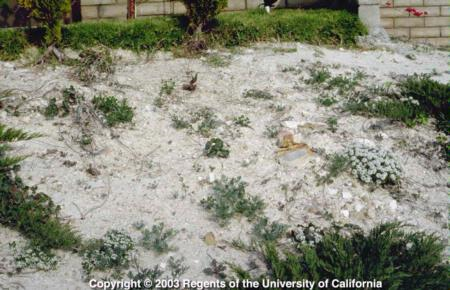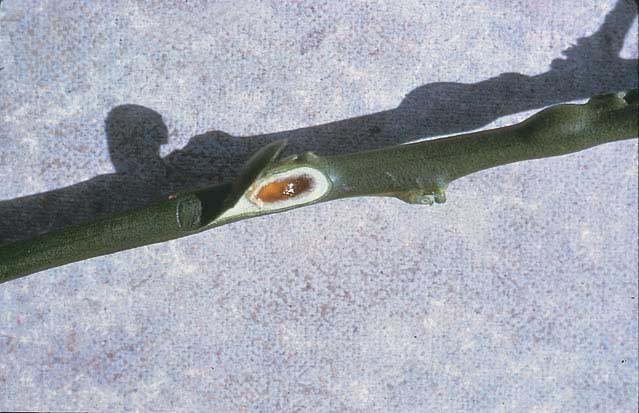
Posts Tagged: copper
Calcareous Soil Confusion
Calcareous soils have often more than 15% CaCO3 in the soil that may occur in various forms (powdery, nodules, crusts etc…). They are relatively widespread in the drier areas of the earth. California is notable for its young soils, that is, soils that have a relatively high level of nutrients because low rainfall means that natural productivity has not been leached out. The potential productivity of calcareous soils is high where adequate water and nutrients can be supplied. Water is the most limiting input to making California soils productive.
The high pH associated with these soils, though, is not the level of calcium present. It is the carbonate in the soil or the bicarbonate associated with the waters found in those soils which controls the pH. The high pH then controls the availability of iron, zinc, manganese and copper. These nutrients need to be added as foliars or soil applied, or better yet, the soil pH needs to be dropped to around 7 to make these nutrients available.
Recently someone asked if replacing the calcium with potassium would change the pH. No, it won't. The carbonate needs to be removed. Calling it a calcareous soil confuses people about what caused the high pH. The carbonate or bicarbonate needs to be removed with acidification, it turning it into CO2 gas. This is done with urea sulfuric acid or sulfuric or sulfurous acid. There are actually magnesium dominated soils in the San Luis Obispo area that have high pHs due to carbonates. They are carbonateceous.

calcareous soil
Copper Deficiency in 'Meyer' Lemon - It Can be Gross
A 'Meyer' lemon should be quite happy along the coast, unless it gets planted in new soil that has low copper because of high soil pH or high organic matter. And then you wonder what is wrong.
Mild copper deficiency is usually associated with large, dark green leaves on long soft angular shoots. Young shoots may develop into branches which appear curved or “S-shaped," referred to as “ammoniation” usually resulting from excessive nitrogen fertilization. It's actually thought to be too much nitrogen relative to copper in the plant and can be corrected by foliar sprays. Twigs can develop blister-like pockets of clear gum at nodes. As twigs mature, reddish brown eruptions may occur in the outer portion of the wood. It can be quite shocking. Severely affected twigs commonly die back from the tip with new growth appearing as multiple buds or “witches broom”. Necrotic-corky areas on the fruit surface may sometimes occur in extreme situations. In some cases fruit cracking occurs with exudates.
Copper deficiency is more likely to occur in new plantings on previously uncropped soils, which are usually deficient or totally lacking in copper. In California, it has been referred to as “corral” disease or “midden” disease because it is associated with high organic matter that ties up the copper, or old Native American sites were debris had been piled. It is often localized in certain areas. Once I saw it on nursery trees that had had inadequate copper in the nutrient solution. I've only seen it on citrus, and not any other subtropical like avocado, but that doesn't mean it can't happen.
I've also seen gummosis similar to this occurring with drought and water management. It more commonly occurs as a twig die back at the tips. And certainly Phytophthora gummosis will show gumming. It's that little gumming pocket under the bark is usually the way to distinguish copper deficiency from these two others.
Pictures: pocket gumming (U. of Florida), oozing (Yara), gumming, and more gumming not a worm

copper deficiency

copper deficicney 2

copper deficiency 3

copper deficiency 4
Zinc and Phosphorus
I was recently in an avocado orchard and saw the rounded fruit and small leaves typical of zinc deficient trees. I asked the grower if there were recent leaf analysis of the orchard, and so we looked at them. The leaves were running at 20 ppm which is low. Sufficiency runs at 50 ppm. The recommendation was to apply zinc sulfate to the soil. The recommendation included, though 200 pounds of phosphorus per acre. Phosphorus and zinc are antagonistic, meaning applying one can limit uptake of the other. In applying phosphorus at such a high rate was probably preventing uptake of zinc. It is also antagonistic to copper, iron and manganese, so all of these micronutrients can be limited by phosphorus applications.
There have only been two documented cases of phosphorus deficiency in fruit trees, walnuts on a volcanic soil in Lake County and oranges on decomposed granite in San Diego. It is an essential element, yes, but applying it when there is sufficiency in the leaves can lead to other problems which can be hard to correct. Generally speaking, phosphorus does not need to be applied to fruit trees in California. In other states that have peat soils, high carbonates or highly weathered soils, phosphorus application is a normal practice, but here make sure you need it before applying it.
